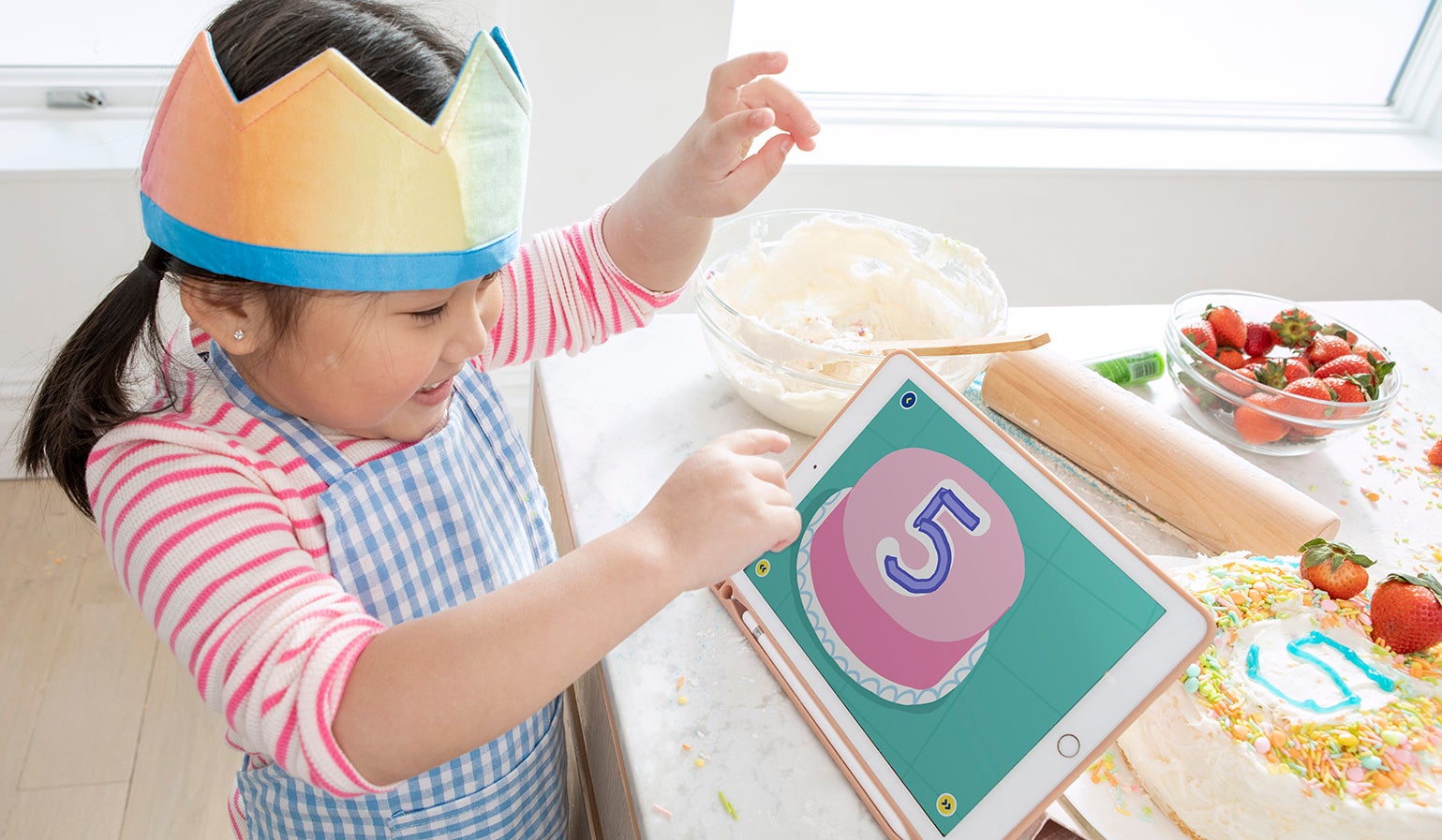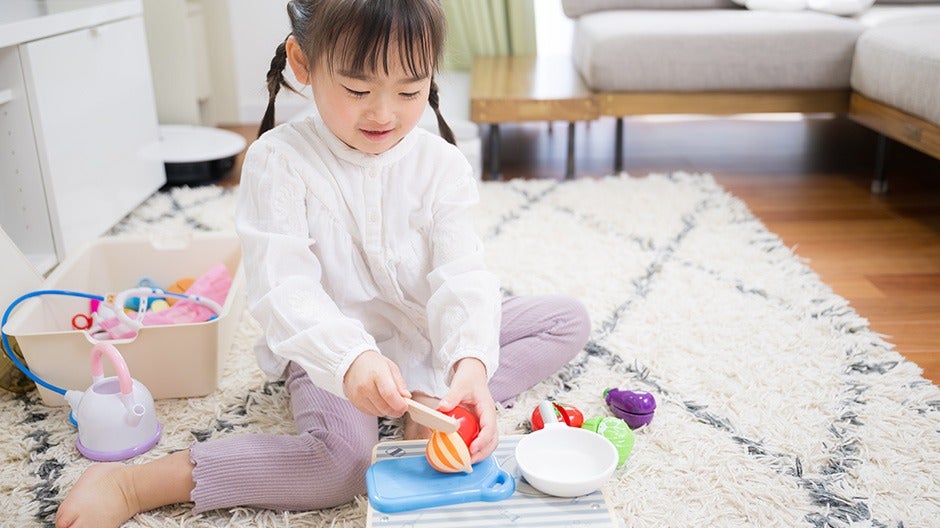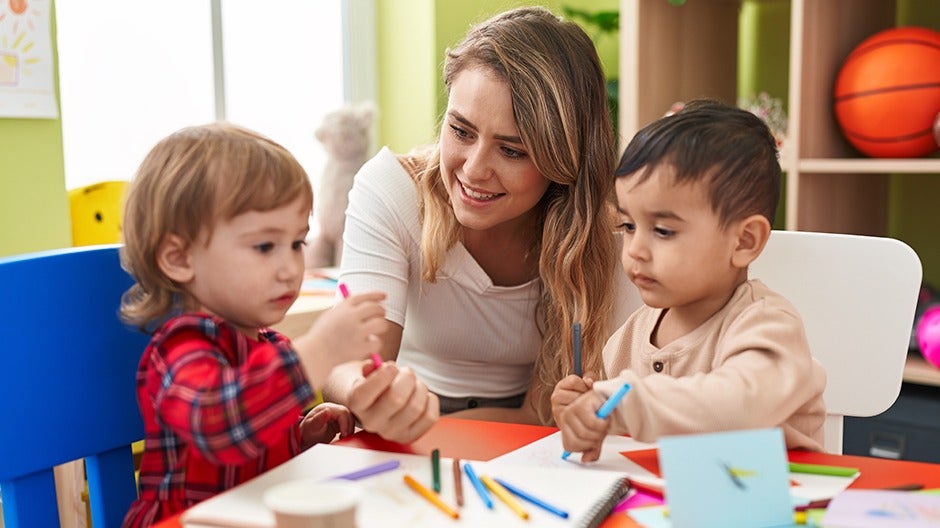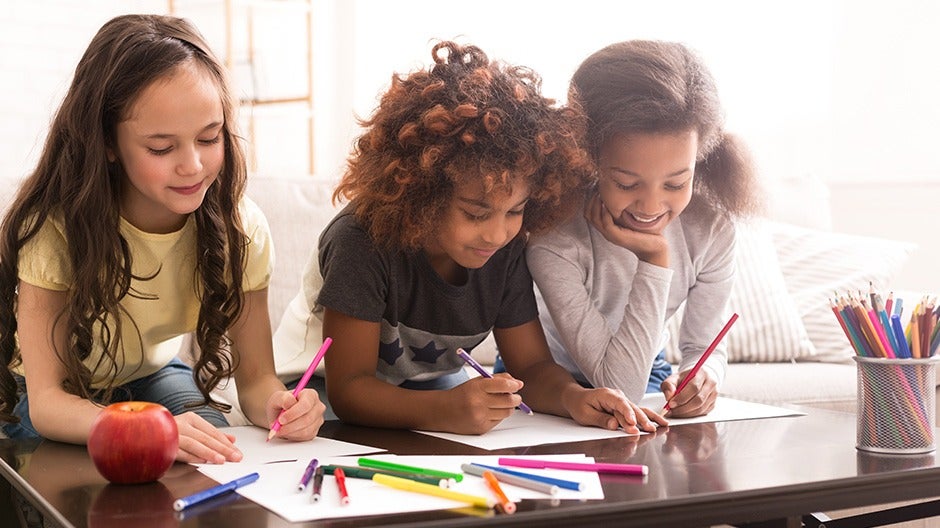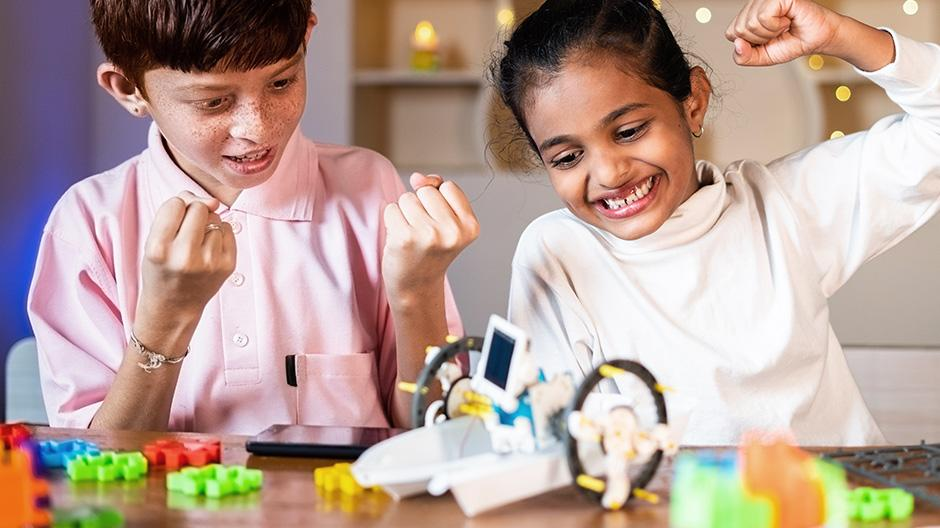What is an “I Did It!” Moment?
Learning is a journey, so progress is something to celebrate! An “I Did It!” Moment is a little (and sometimes big) win on the way to lifelong learning. They happen when something “clicks,” and your child can take what they’re learning and make it their own. They’re the big-smile-inducing, fist-pumping, dance-party-sparking, “we finally got there” moments that lead to a lifelong love of learning.
They give kids the confidence to ask questions, find solutions, and create their own path in the world. Kids can celebrate big moments—like counting to 100 or reading a book—and the little wins that help them get there.
How Grown-Ups Can Help
For grown-ups, the trick to encouraging “I Did It!” Moments is learning how to spot them in the wild! “I Did It!” Moments can happen anytime and anywhere: on the playground, at the grocery store, at the dinner table, you name it!
Our Begin experts have rounded up a list of essential skill-building moments to keep an eye out for, along with tips, games, activities, and books to foster these skills and make learning fun (for both of you!)
During Playtime
Sorting and Classifying
Look For: Separating the big blocks from the small blocks or gathering multiple stuffed animals of the same species to create a family. You can encourage a child to foster this skill by:
Making clean-up time fun: sort toys in bins or baskets by size or color.
Taking it outdoors: gather items on a nature walk, and sort what you find (leaves by color or shape and flowers by color). They might surprise you by sorting by furry flowers or flowers from their friend Juno’s house. As long as kids have a rationale for why they’re sorting something, it’s fair game.
Letter Formation
Look For: Drawing letters or shapes in sand or dirt at the playground. You can encourage a child to foster this skill by:
Making it a sensory experience: practice letter tracing with different textures: sand, rice, shaving cream, whipped cream, finger paint.
Getting moving: try alphabet yoga (or throw it back with a “YMCA” dance party.)
Working on fine motor skills: help your child get their muscles ready to hold a pencil by getting out the playdough, practicing cutting with child scissors, or crumpling paper.
Verbal Counting
Listen For: Using number words (even if they aren’t in the correct order) when counting objects like blocks, snacks, or stuffed animals. You can encourage a child to foster this skill by:
Making it musical: sing counting songs together.
Playing Hide N’ Seek: take turns counting and hiding.
Play: Just Count in the Learn & Grow App
Arts and Crafts Time
Identifying Simple Shapes
Look For: Drawing simple shapes within their artwork (e.g., a square or circle for a window). You can encourage a child to foster this skill by:
Getting crafty: make a shape collage or potato-print shapes.
Baking together: use geometric cookie cutters and talk about the shapes.
Play: Castle Creator in the Learn & Grow App
Self-Expression through Art
Look For: Drawing, singing, dancing, and creating with joy and inhibition. You can encourage a child to foster this skill by:
Setting them up for creativity: provide materials that lend themselves to creative expression like play dough, pipe cleaners, paint, and crayons.
Starting a dialogue: when viewing their next masterpiece, instead of asking “What’s that?” tell them what you see (colors, lines, etc.), and invite them to tell you more about their creation.
Making time and space for crafts: choose a final project that incorporates following directions and experimenting with their own ideas.
Jamming out: make music together with simple instruments like maracas, drums, or a ukulele – or have a dance party!
In the Car
Using Ordinal Numbers
Listen For: “Can I get in first?” the next time you are about to hit the road. You can encourage a child to foster this skill by:
Using ordinal numbers in context: integrate them into the conversation by talking about days of the week (e.g., “Monday is the first day of school.” “Sunday is the last day of the weekend.”)
Sequencing: narrate what do you do first in the morning, second, etc.
Learning through storytime: read Pancakes for Breakfast by Tomie DePaola together
Play: Wacky Slide in the Learn & Grow App
Print Awareness
Look For: Pointing out signs on a morning walk or drive, asking a grown-up to read written words in a book or on a menu, or scribbling on paper. Print awareness is the understanding that printed words convey meaning and have various functions depending on the context.
Encourage a Child to Foster This Skill By:
Exploring all the exciting places and purposes for print: books, signs, letters, etc.
Opening the mail together: read any cards or notes aloud.
Putting it in practice: label objects around the house together.
Getting crafty: make (or pretend to make) birthday cards, shopping lists, or signs.
Out and About
Letter Recognition
Look For: Pointing out letters on signs or buildings (e.g., “B”!) You can encourage a child to foster this skill by:
Playing I spy in real-time: while on a walk together or out and about, build excitement by saying, “I wonder how many Bs we can spot! I spy one on that sign — do you see it?” See how many letters you can find!
Expanding Vocabulary
Listen For: Using a new word, even if they don’t pronounce it correctly. You can encourage a child to foster this skill by:
Not limiting your vocabulary: when you talk to your child, use the same words you’d use speaking to an adult.
Taking it to the next level: use unexpected words for everyday events (e.g., “Let’s take a stroll” instead of “a walk” or “I consumed so much pizza tonight!” instead of “I ate”).
Playing Word of the Week: pick out some fantastic words (e.g., scrumptious, stupendous, irresistible) and introduce one a week. On day one, announce the word, and then use it as often as possible during the week; encourage your child to do likewise! (e.g., “Oh, that pizza is scrumptious!” “What scrumptious thing should we have for lunch today?”)
In Conversation
Identifying Feelings
Look and Listen For: Using feeling words (e.g., happy, sad, mad, etc.) or emotive facial expressions. You can encourage a child to foster this skill by:
Noticing and reflecting: Notice your child’s feelings and reflect what you see back to them. (e.g., “It looks like you might be feeling sad about something.”)
Validating their feelings: Instead of “There’s no reason to be so upset!” try something like, “It looks like you are feeling sad. I get sad sometimes, too. Let’s take a deep breath together to help us feel a little better.”
Share your feelings: Kids like to hear about positive feelings adults have. While it may seem obvious you can say things like, “I am in such a silly mood today.”
Building Memory
Listen For: Recalling things they have done recently (playtime with a friend, a story they heard, or what happened at a birthday party). You can encourage a child to foster this skill by:
Flipping the script: let your child teach you how to do something.
Playing memory games: Uno, Go Fish, and matching card games are all great choices.
Breaking down information: give instructions one at a time; breaking info into smaller chunks makes it easier to digest.
Gamifying clean-up time: when it’s time to clean up the room, ask your child to do the tasks in a particular order (e.g., “First, pick up all the blocks. Then, put the stuffed animals on the bed, and next, put your doll in their bed.)
Playing Simon Says: you can create a variation of the classic by giving three instructions in a row (e.g., “jump two times, clap your hands, wiggle all over.) Have your child wait until you count to five before starting to make it a memory challenge.
Engaging their senses: for chores, morning routines, and anything with multiple steps: write and draw each step in addition to saying them out loud.
Making Connections
Listen For: Relating something they learn to themselves, your family, or an experience they’ve had. (e.g., exclaiming “Our puppy is a carnivore!” after reading a book about carnivorous animals.) You can encourage a child to foster this skill by:
Reading informational books together: dive into books about animals, places, etc., to help build their background knowledge.
Going places and seeing things: talk about what you might see or do before the trip and then again after. You can also read books that relate to the day’s adventure. They can be far or near; the library, the post office, a farmer’s market, a local nature walk, or a favorite museum are easy and fun starting points.
Engaging in dramatic play: give them a chance to put their knowledge into practice.
Dinner & Snacktime
Counting
Look For: Using number words, even if they aren’t necessarily the right ones! Understanding the principle of counting, that individual numbers can be grouped and quantified is a big deal and can take some time to develop. You can encourage a child to foster this skill by:
Narrating with number words: create a “voice over” for your everyday routine (e.g., “I need three eggs for this: one, two, three.”) to familiarize them with what numbers represent. When you finish counting, reinforce the last number by saying something like, “Ah! Now I have three eggs in all.”
One-to-One Correspondence
Look For: Practicing setting the table (one plate for each person, one knife, etc.) You can encourage a child to foster this skill by:
Try it out at snack time: work on the concept of everyone getting one treat; hand out one treat to each person until everyone has just one treat.
Spatial Concepts
Look For: Following directions that involve words like on, under, over, above, and next to (e.g., “Can you put the slippers under the bed,” or “Please pick up the book on the table.”) You can encourage a child to foster this skill by:
Playing I Spy with a stuffed animal: use spatial words as you guess, “Is it behind the chair? On the bottom shelf?”
Using spatial words: when you talk to your child throughout the day, add clear spatial words into the vocabulary you use (e.g., “Let’s take off our shoes when we go in the house.)
Cause and Effect
Look For:
- Bargaining: “If I eat all my dinner, can I have dessert?”
- Asking questions: “Why did you do that?”
- Making predictions: “I bet she is going to be excited!”
- Reflecting on why things happen: “He cried because he fell.”
Encourage a Child to Foster This Skill By:
Dreaming up experiments: think of fun, easy ones to do at home – like finding out what happens when you mix blue and red paint (or playdough) or when you combine soap and water in a bowl.
Playing with bubbles: talk about cause and effect as you play (e.g., “What happens when you touch the bubbles? What about when you blow on them?”)
Playing sink or swim: guess which bath toys will sink to the bottom and float on the water.
Singing songs: I Know an Old Lady is a classic cause-and-effect tune.
Making predictions while reading: during storytime, pause to talk about what they think might happen next. You can even read books centered around a cause and effect, like If You Give a Mouse a Cookie.
With Friends
Emotional Expression
Listen For: Feelings statements like “I’m mad,” I’m happy,” or “I’m angry.” You can encourage a child to foster this skill by:
Modeling emotional expression and regulation: by being honest about your feelings (to an age-appropriate level), you’re teaching your child that it’s okay to have emotions and showing them how to express what they’re feeling in a healthy way. (E.g., “Today I am feeling happy because we are going to see Nana” or, “I think I’ll take a deep breath to calm down. I can’t find my keys/my book.”)
Adding the empathy element: model how to consider other peoples’ feelings and show them you care (e.g., “I’m worried today because Aunt Sally isn’t feeling well. I want her to feel better. Do you want to call and tell her we are sad she is sick?)
Head to the Feelings Forest: Our Explore Feelings Kit brings emotions to life for ages 3-6 with hands-on play prompts and activities.
Perspective-Taking
Look For: Considering another child’s feelings when they tell a story (e.g., “Lucy is happy because I gave her a drawing.”) You can encourage a child to foster this skill by:
- Modeling this behavior in practice: talk through your thought process. (e.g., “We need to get Uncle Dave a present for his birthday. I wonder what he would like.”)
- Inviting them to participate: ask for their input when considering others (“e.g., What do you think we should get Uncle Dave?”) and encourage considerate behavior (e.g., “What a great idea! How did you ever think of that?”)
At Begin, we know that learning isn’t about perfection; it’s about progress. We create opportunities for kids to have “I Did It!” Moments in everything we do so that learning makes kids feel good about themselves, proud of their skills, and excited about the world around them. Remember, kids learn in different ways and at different speeds; that’s okay. As long as learning is fun, they’ll keep learning!
